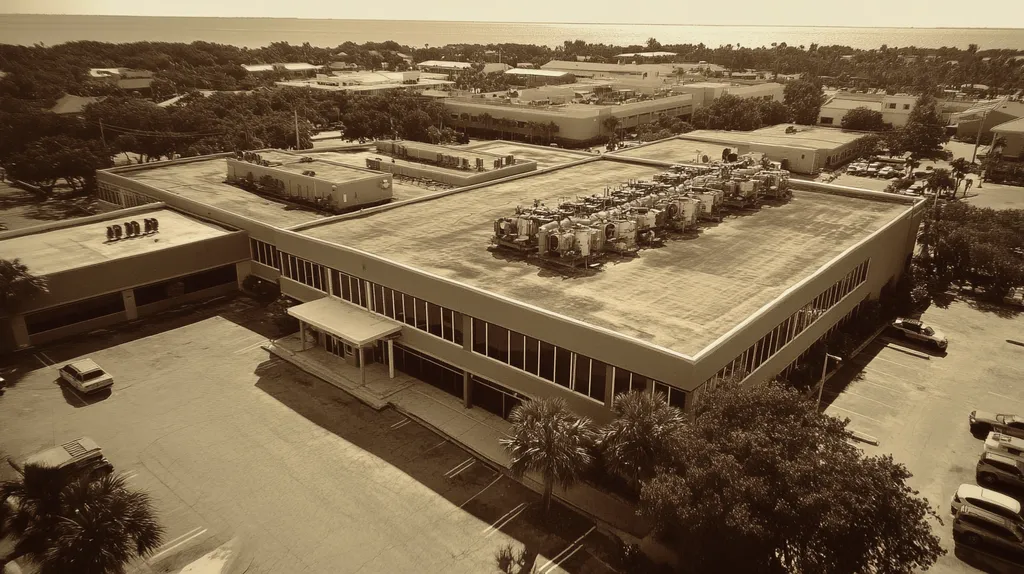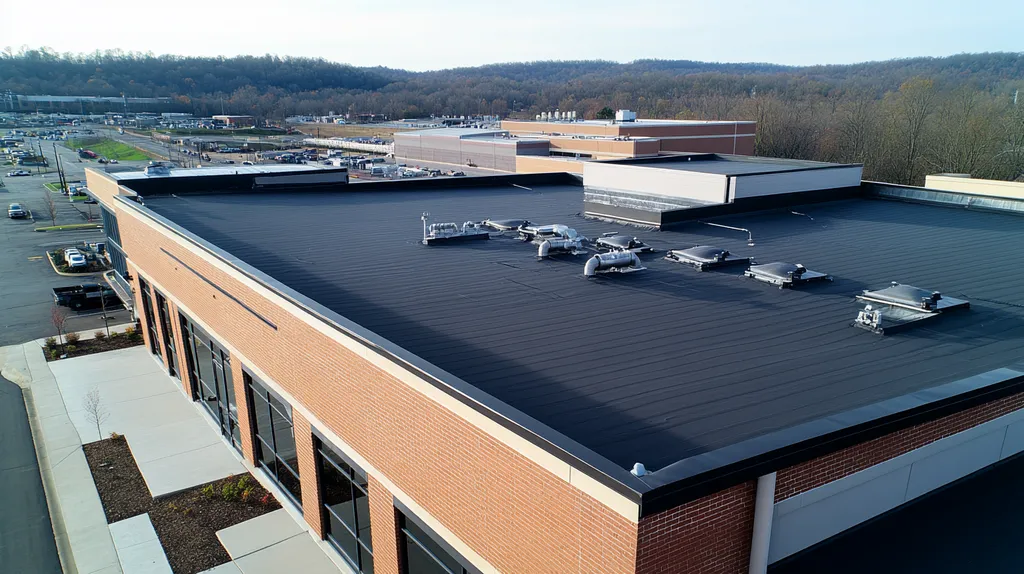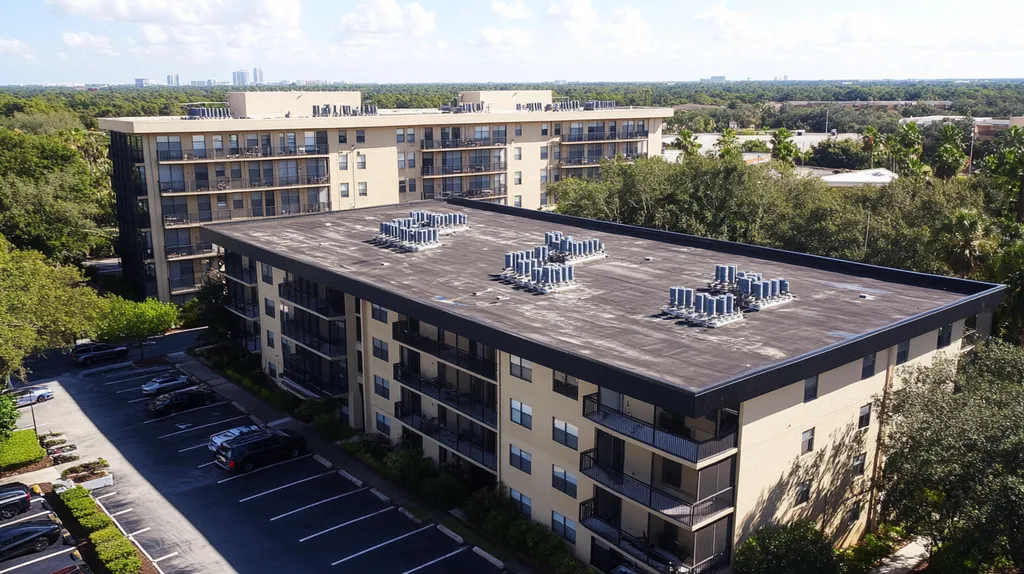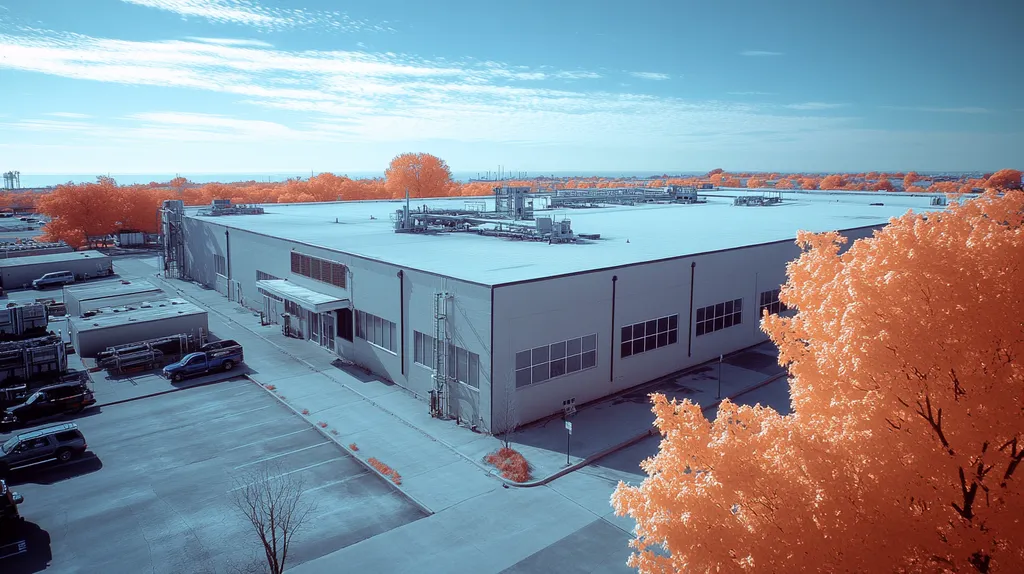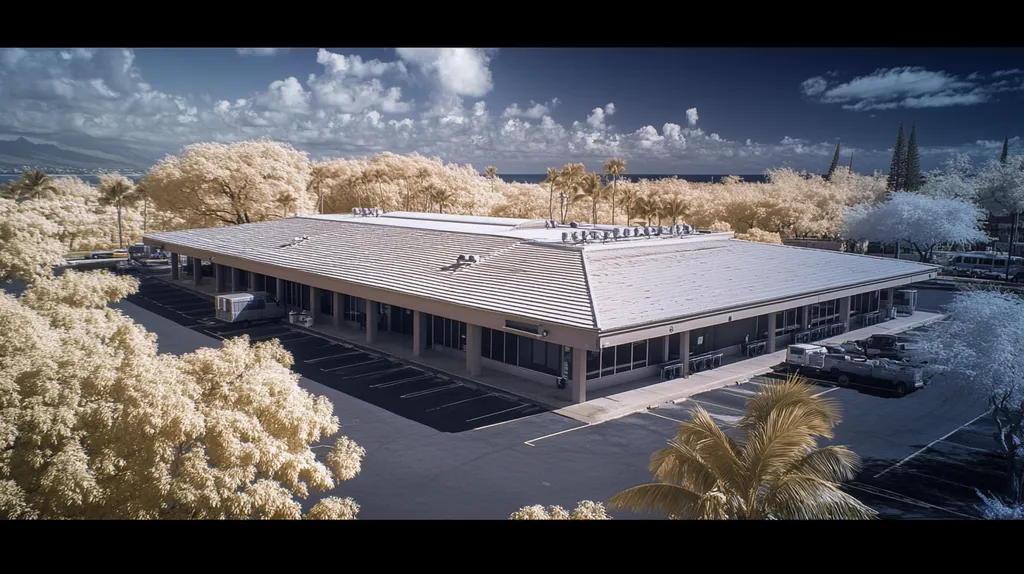Commercial roof coating costs have risen by 23% since 2020, yet industry data shows that over 40% of applications fail prematurely due to improper cost assessment and planning.
The traditional factors used to determine coating costs – square footage, material selection, and basic labor rates – often overlook critical variables that impact long-term performance and total investment.
This comprehensive analysis challenges established cost metrics while examining systemic issues, missed opportunities, and evidence-based solutions that are reshaping how the industry approaches coating application pricing.
SECTION 1: CURRENT PRACTICES
The commercial roofing sector is grappling with escalating costs and an increasing push for eco-friendly choices. Recent studies indicate that over 25% of roof replacements incorporate coating applications. However, many property owners are unclear about the factors that influence pricing. Grasping the existing cost estimation practices and material options is essential for making sound financial decisions. Neglecting these complexities may result in costly surprises.
Standard Cost Estimation Methods
Cost estimation for roof coating applications often adopts a one-size-fits-all approach, which can obscure vital variables. Common practices focus on square footage, failing to consider the specific condition of the roof, existing materials, or the level of preparation necessary. For example, a flat roof requiring extensive repairs may incur additional costs that standardized estimates overlook.
Accurate estimates should also analyze environmental factors, such as local weather conditions that could affect the durability of coatings. Ignoring this critical assessment leads property owners to believe they are making affordable choices, only to encounter difficulties later.
Conversely, customized cost estimates that account for each roof’s unique traits can enhance financial outcomes. This includes detailed evaluations of previous repairs, warranty stipulations, and any potential need for specialized application methods.
Failure to adopt a more nuanced estimation strategy can result in budget overruns and inadequate roofing solutions, which may not perform as expected over time.
Common Materials and Applications
Selecting the right materials is vital for roof coating applications. However, many property owners stick to familiar options without exploring better alternatives. Typical materials include acrylics, elastomerics, and silicone, each with its own pros and cons. While acrylic coatings are often budget-friendly and easy to install, they may not endure extreme weather as effectively as silicone coatings.
The application process also plays a significant role in performance and costs. Certain coatings require a primer, while others can be applied directly. This variance affects project timelines and labor expenses. Metal roofs, for instance, frequently require specialized coatings to enhance adhesion and longevity.
Investing time in researching suitable materials helps property owners avoid costly failures and frequent reapplications. Many focus on initial costs rather than the total lifecycle expenses related to material choices.
Ultimately, informed material selection should encompass both immediate and long-term impacts, ensuring property owners do not face unexpected costs for repairs or premature replacements.
Labor Costs and Contractor Fees
Labor costs and contractor fees are significant components of total coating expenses but often remain unclear to property owners. Factors influencing contractor pricing include their level of experience, regional market rates, and project complexity. Opting for a seasoned contractor might require a higher initial investment, yet it often results in superior craftsmanship and longer-lasting roofs.
Additionally, payment methods can significantly affect total costs. Fixed-price contracts may appear appealing but can lead to corners being cut if unexpected challenges arise, while hourly rates may escalate quickly. Clear communication about cost structures is crucial for property owners to understand exactly what they are paying for.
Moreover, aspects such as crew size and efficiency can greatly influence the duration of a project. A larger, well-equipped team might reduce labor time but could also result in higher upfront costs. Striking a balance between quality and cost-effectiveness is key in the decision-making process.
To mitigate potential challenges, property owners should seek detailed quotes from multiple contractors. This practice not only aids in cost comparison but also highlights any essential warranties and post-installation services included in the agreement.
SECTION 2: SYSTEMIC ISSUES
In commercial roofing, neglecting systemic issues can lead to underestimated costs and project failures. Contractors who rush or bypass key evaluations can cause property owners to overspend. For instance, research shows that an inaccurate roof condition assessment can inflate replacement costs by as much as 30%. Addressing these fundamental issues is essential for maintaining budget integrity and ensuring successful project outcomes.
Inaccurate Roof Condition Assessments
Many contractors perform surface-level inspections, often missing critical underlying issues. This superficial approach leads to an incomplete understanding of a roof’s condition, affecting cost estimates significantly. Hidden damage from past leaks or general wear can worsen over time, resulting in more costly repairs or premature coating failures.
A comprehensive roof assessment should evaluate factors like membrane integrity, insulation levels, and current wear patterns. Many commercial roofs consist of multiple layers, and failing to conduct thorough inspections can result in decisions based on incomplete data. This jeopardizes both budget expectations and the longevity of any coating application.
By prioritizing detailed evaluations, property owners can avoid these pitfalls. Accurate assessments help in forecasting costs more effectively and setting aside adequate funds for unexpected repairs. A proactive approach can ultimately save money in the long run.
Although industry standards recommend regular roof condition assessments, many property owners either skip or rush this essential step. Raising awareness about the significance of thorough inspections can help align budget expectations with the reality of roof conditions, leading to successful coating applications.
Overlooking Preparation Costs
Preparation is often an afterthought in commercial roofing projects, resulting in unexpected cost escalations. Property owners might be lured in by an initially low quote, but the final costs can increase dramatically without proper preparation. Tasks like cleaning and priming the roof surface can add both time and material expenses.
Properly preparing a roof involves several steps, including removing debris, fixing any existing damages, and applying primers. Neglecting these critical actions jeopardizes the adhesion of the coating and leads to quicker deterioration. Thus, understanding preparation costs upfront is vital for accurate budgeting.
Some contractors may present deceptively low estimates that fail to include essential preparation steps. This can create a misleading price landscape, tempting property managers to believe they are making cost-effective choices. Unfortunately, poor-quality results could necessitate complete reapplications sooner than expected.
Property owners should insist on detailed proposals that itemize preparation costs along with materials and labor. This transparency not only aids in informed decision-making but also supports the long-term health and durability of the roof.
Geographic Variations in Labor Rates
Labor rates for roofing projects can vary significantly depending on geographic location, ultimately affecting overall costs. In high-cost living areas, labor charges often rise, altering the affordability of coating applications. Comparing estimates from different regions may reveal significant discrepancies attributed to these regional variations.
Understanding local labor costs is crucial for property owners aiming for accurate budgets. For example, commercial buildings in metropolitan areas may face labor rates that are 20% higher compared to similar projects in rural locations. This fluctuation can impact cost expectations and complicate the process of obtaining competitive bids.
Additionally, seasonal labor availability can affect pricing. During peak seasons, increased demand can raise costs and delay project timelines. Property owners must consider not just the base labor rate, but also the timing and availability of skilled labor in their region.
Incorporating geographic labor analysis into budgeting provides a clearer financial picture. This knowledge empowers property owners and managers to make informed decisions, ensuring that coating applications are both financially viable and strategically timed.
SECTION 3: MISSED OPPORTUNITIES
Many property owners underestimate the financial impact of overlooking roof coating applications. While the initial costs of these coatings often dominate decision-making, neglecting their long-term benefits can lead to costly inefficiencies. Research indicates that reflective coatings can cut energy expenses by as much as 30%. Recognizing the broader consequences of these decisions is essential for tapping into substantial savings and enhancing the lifespan of commercial roofs.
Ignoring Long-Term Energy Savings
Many property owners place undue emphasis on upfront costs when evaluating roof coatings. However, these coatings offer significant energy-saving benefits through improved insulation and reflectivity. For example, a white elastomeric coating can reflect sunlight, keeping buildings cooler and cutting down on air conditioning expenses.
By failing to consider potential energy savings, property owners risk missing a substantial reduction in operating costs. Research shows that a well-coated roof can yield savings exceeding $1,500 annually for large commercial spaces. This crucial factor should play a significant role in financial decision-making.
Additionally, implementing energy-efficient measures often unlocks tax incentives and rebates, further enhancing savings. Owners are encouraged to look at the total cost of ownership, which provides a full financial perspective beyond immediate expenditures.
By factoring in energy savings, property owners not only reduce costs but also advance their sustainability goals. This strategic approach turns roofing decisions from mere maintenance into valuable long-term investments.
Neglecting Climate and Weather Factors
The local climate significantly impacts the effectiveness of roof coatings. Different regions face specific weather challenges that can influence coating performance. For instance, roofs in areas prone to extreme heat may require different materials compared to those in colder climates.
Overlooking local weather conditions can lead to premature failure of the coatings. Coatings designed for arid environments might not adhere well in humid or rainy regions, resulting in expensive repairs. It’s vital for property owners to select coatings that suit their climate.
Long-term durability also depends on seasonal variations. In some areas, prolonged freezing temperatures can cause lower-quality coatings to become brittle and crack. Owners should actively seek expert advice to identify the best solutions tailored to their local conditions.
Aligning coating choices with climatic realities ensures enhanced longevity and performance. This diligent consideration of environmental factors ultimately saves time and financial resources, highlighting the importance of well-informed decisions.
Overlooking Potential for Extended Roof Life
Maintaining a commercial roof frequently involves costly repairs or complete replacements. However, strategic coating applications can significantly prolong a roof’s lifespan. Many coatings offer protection against UV damage and weather-related wear, essentially revitalizing aging roofs.
When facility managers dismiss the rejuvenation potential of roof coatings, they forfeit the chance to extend the life cycle of the roof. High-quality coatings can add an extra 10 to 15 years to a roof, delaying the need for full replacement and yielding substantial savings on capital expenditures.
Moreover, prolonging roof life enhances the overall value of the building while reducing tenant disruption. New roof installations often create significant interruptions, so minimizing these events is beneficial for property owners.
Investing in the right coatings helps safeguard existing investments and contributes to better future property valuations. The opportunity for extended roof life should be a critical consideration in any comprehensive roofing strategy.
SECTION 4: ROOT CAUSES
Identifying the root causes behind inflated coating application costs is crucial for property owners seeking to protect their budgets. Failing to conduct thorough roof inspections often leads to unexpected complications, while poor material selection can result in premature failures and increased expenses. Additionally, insufficient consideration of roof complexity can exacerbate these issues. Addressing these root causes is vital for effective cost management and smarter roofing investments.
Lack of Comprehensive Roof Inspections
A comprehensive roof inspection is essential, not optional. Many property owners opt for quick visual assessments, which often miss critical issues like hidden leaks, structural damage, or deteriorating membranes.
Without these thorough inspections, property managers might select coatings that fail to address the real problems. This oversight can drive up maintenance costs and necessitate premature reapplications. Furthermore, undiscovered issues can worsen over time, leading to even higher repair expenses.
For example, a building that appears structurally sound could actually harbor mold or extensive water damage revealed only through a detailed inspection. Addressing these hidden problems early can prevent costly mistakes later.
Investing in comprehensive inspections ultimately leads to informed decisions and effective coatings, extending the roof’s lifespan and saving money in the long run. Expect to allocate between $150 and $350 for a professional evaluation to ensure the roof is suitable for coating (source: Renova Roofing).
Inadequate Material Selection Criteria
The choice of roofing materials is critical in determining coating application costs. Many facility managers underestimate the importance of selecting appropriate materials based on specific roof conditions. When unsuitable materials are chosen, it can lead to early failures and significant long-term expenses.
Choosing the correct coating involves understanding various factors, such as climate conditions, roof slope, and existing material compatibility. Overlooking these elements may result in peeling, blistering, or prematurely needing repairs.
For instance, using a budget coating on a heavily trafficked roof might save initial costs, but can eventually result in expensive repairs due to damage from foot traffic or environmental factors.
Therefore, investing time in appropriate material selection may seem burdensome, but it reduces the likelihood of costly reapplications and keeps the roof in better condition.
Insufficient Consideration of Roof Complexity
Complex roofs—those featuring multiple elements like skylights and varying slopes—present specific challenges that can significantly increase coating costs. Property owners often underestimate the impact of these complexities on the roofing process. A straightforward flat roof generally requires less material and labor than a roof with multiple angles and penetrations.
Neglecting to factor in these complexities can lead to unexpected cost overruns due to increased labor needs and material wastage. For example, complex roofs demand more labor to address seams and flashing points, which require special attention.
Additionally, because advanced designs may necessitate specialized coatings, these products can come at a premium compared to standard options. Choosing a generic coating without assessing the unique requirements of a complex roof can lead to higher long-term costs.
Incorporating the complexity of roof designs into budgeting creates smarter investments and enhances maintenance strategies, ultimately benefiting the roof’s longevity and financial efficiency.
DATA DRIVEN EVIDENCE
Understanding the cost of roof coating applications is crucial for commercial property owners. The financial implications can vary significantly, influenced by factors such as roof size, type, and local labor rates. Reports indicate that costs can fluctuate by as much as 50% based on these parameters. A comprehensive analysis of these elements is essential to ensure informed decisions and effective budgeting.
Cost Variations by Roof Size and Type
The size and type of a roof are critical in determining coating application costs. Typically, larger roofs incur increased material and labor expenses. For instance, flat commercial roofs often necessitate different preparation and application techniques compared to sloped metal roofs.
Moreover, specific roof types require unique coatings that match their material properties. Single-ply membranes, for example, may call for specialized coatings that could be pricier than standard asphalt roof options. Understanding these distinctions is essential to avoid unexpected financial burdens.
To minimize surprises, facility managers should request quotes that accurately reflect their roof type. This approach promotes more precise financial forecasting and aids in setting realistic budgets.
Ultimately, recognizing the interplay between roof size, type, and associated costs empowers property owners to make sound investments in their roofing solutions. This informed decision-making can lead to substantial savings while maximizing the overall performance of the roof.
Impact of Local Labor Rates on Costs
Local labor rates significantly impact the total costs associated with roof coating applications. In metropolitan regions, the high demand for skilled labor often drives up wages, which can affect overall project budgets. For instance, a facility manager in a major city might encounter labor costs that are 20% higher than those in rural areas.
These regional differences should prompt property owners to analyze local market conditions carefully. Gathering multiple contractor bids can expose these disparities, allowing for improved financial planning.
Additionally, geographic challenges—like urban regulations or remote locations—can affect both labor availability and costs. Understanding these local dynamics is essential for facility managers when estimating accurate pricing strategies.
By proactively evaluating local labor rates, property owners can better budget for coating projects. This awareness fosters strategic decisions that mitigate financial risks associated with labor costs.
Comparative Analysis of Coating Materials
The selection of coating materials is another vital factor influencing costs in roof coating applications. Various materials, such as acrylic, silicone, and polyurethane, provide differing levels of protection and performance. For instance, silicone coatings are recognized for their superior waterproofing capabilities but tend to have a higher initial cost.
The long-term durability of each material also plays a crucial role in determining lifecycle costs. While the upfront investment for high-performance coatings may be greater, they can yield significant savings over time by reducing the frequency of necessary reapplications and repairs.
Furthermore, it’s essential to consider the environmental attributes of each material. Some coatings possess energy-efficient properties, which can substantially lower cooling costs, presenting a dual advantage in budget considerations.
Evaluating the benefits and drawbacks of various coating materials allows property owners to make informed choices aligned with their financial objectives and performance needs. A thorough understanding of these options is critical for achieving optimal investment outcomes in commercial roofing.
SECTION 6: ALTERNATIVE SOLUTIONS
Property owners face high stakes when relying solely on standard roof coating methods. Neglecting integrated solutions can lead to inflated costs and quicker deterioration. In fact, over 50% of coating failures arise from insufficient prior inspections and repairs. This section emphasizes the necessity of comprehensive roof inspections, climate-specific coating options, and efficient labor techniques to improve durability while reducing expenses.
Integrated Roof Inspection and Repair
Thorough roof inspections are essential for uncovering underlying issues before any coating is applied. Each year, many roofs experience problems like leaks or structural damage that can compromise the integrity of coatings. For example, a facility manager might discover that a coating is failing prematurely due to unaddressed cracks hidden beneath the surface.
By combining thorough inspections with necessary repairs, property owners can ensure that coatings are applied to a solid, reliable base. This proactive method significantly reduces the risk of coating failure, which can result in costly maintenance and replacements. Selecting inspectors with expertise in both roofing and coatings is paramount for achieving long-term success.
Modern technology, such as infrared scanning and drone inspections, can further enhance inspection accuracy. These advanced methods provide detailed insights that conventional inspections may overlook. Understanding the roof’s true condition in advance allows for tailored coating applications, ultimately leading to better performance and durability.
In summary, integrating inspections and repairs into the coating process elevates protective strategies and reduces future costs. This comprehensive approach is critical for safeguarding roofing investments and enhancing overall building performance.
Customized Coating Selection Based on Climate
The link between climate and coating effectiveness is crucial. Failing to consider environmental conditions can lead to poor coating choices. For example, roofs located in hot, sunny regions require different protective features compared to those in humid, rainy areas.
Tailoring coatings to local climates improves the roof’s durability and efficiency. Reflective coatings can lower energy costs in hotter climates, while moisture-resistant formulations can safeguard roofs in wetter regions. Understanding local weather patterns provides property owners with the knowledge needed to choose the most effective products.
Moreover, consulting with material manufacturers can lead to coatings specifically designed for various regional climates. This collaboration offers high-performing solutions beyond the reach of traditional one-size-fits-all coatings. Ultimately, informed selections that consider climate can maximize investments and extend the lifespan of roof systems.
Therefore, property owners should adopt a customized approach to coating selection, recognizing how unique climate conditions impact roof performance. This foresight will result in cost savings and enhanced longevity, generating substantial long-term advantages.
Optimizing Labor Costs Through Efficient Application Techniques
Labor costs are a major component of coating application expenses. By utilizing more efficient application methods, businesses can achieve significant savings. Traditional methods can be time-consuming, resulting in inflated labor costs and extended project timelines.
Implementing advanced application techniques, such as spray-on methods, can greatly accelerate the coating process. These techniques allow for a uniform coat to be applied faster than using brushes or rollers, reducing labor costs without sacrificing quality. Equipping crews with the right tools and training enhances efficiency and precision in application.
Additionally, scheduling applications during optimal weather conditions helps to prevent delays and ensures proper setting of the coating. Well-timed applications can mitigate potential issues like rain damage or temperature-related problems. This careful planning contributes to successful and cost-effective projects.
In conclusion, optimizing labor through efficient application techniques is vital for managing costs in coating applications. Embracing modern methods and strategic scheduling empowers property owners to maintain budgetary discipline while achieving high-quality outcomes.
Moving Forward
The commercial roofing industry faces a critical inflection point, with coating costs rising 23% since 2020 while 40% of applications continue to fail prematurely.
Traditional cost estimation methods that focus solely on square footage, basic materials, and standard labor rates are proving increasingly inadequate in today’s complex roofing environment.
Property owners who embrace data-driven assessment methods, climate-specific material selection, and integrated inspection protocols can expect to reduce coating costs by 15-30% while extending roof life by up to 15 years.
The path forward requires a fundamental shift from simplistic cost metrics to comprehensive evaluation systems that consider climate impacts, energy efficiency, and long-term performance factors.
Success in commercial roof coating now demands moving beyond outdated pricing models to embrace evidence-based solutions that maximize return on investment.
FREQUENTLY ASKED QUESTIONS
Q. What factors influence commercial roof coating costs?
A. Various factors influence the cost of coating applications. These include roof size, type, surface preparation needs, and local labor rates. Additionally, the condition of the existing roof and the chosen materials can significantly affect total expenses.
Q. How does the commercial roof inspection impact overall costs?
A. Comprehensive roof inspections are vital to avoid unexpected costs. Neglecting these evaluations may lead to miscalculated budgets due to unforeseen issues, resulting in inflated repair or coating costs. Ensuring thorough assessments helps in making informed financial decisions.
Q. Why should property owners consider long-term energy savings for their industrial roof?
A. Long-term energy savings from reflective coatings can significantly reduce operating costs. Many coatings improve insulation and reduce cooling expenses, with potential savings reaching up to 30%. Property owners should include these financial benefits in their decision-making process.
Q. How can improper material selection affect commercial roof costs?
A. Using inappropriate materials can lead to early failures and higher maintenance expenses. If the selected coating does not suit the specific roof or environmental conditions, issues like peeling or cracking may arise, resulting in costly repairs or replacements sooner than anticipated.
Q. What impact do geographic labor rates have on commercial roof projects?
A. Geographic labor rates greatly affect overall project costs. Areas with a higher cost of living typically incur increased labor charges, leading to potential budget adjustments. Property owners should consider these local rates when estimating project expenses to ensure accurate budgeting.
Q. How do alternative solutions improve commercial roof coating outcomes?
A. Alternative solutions, such as integrated inspections and climate-specific coatings, enhance durability and performance. Relying solely on traditional methods may lead to premature failures, while comprehensive strategies can optimize costs and improve the overall lifespan of the coating applications.
Q. What are the important elements for successful contractor selection?
A. When selecting a contractor, consider their experience, customer reviews, and warranty offerings. It’s crucial to obtain detailed quotes regarding labor costs and project expectations. Transparent communication about project scope and potential challenges will help ensure a successful collaboration and outcome.

